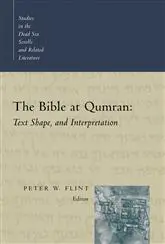

The Bible at Qumran: Text, Shape, and Interpretation
in Studies in Dead Sea Scrolls & Related Literature
Pages
266
Publisher
Eerdmans
Published
4/1/2001
ISBN-13
9780802846303
The Bible at Qumran puts the Dead Sea Scrolls to use in exploring two principal themes: the text and shape of the “Bible” at Qumran and the interpretation of these scriptures in this fascinating Jewish community. Written by leading scholars in the field, these informed studies make an important contribution to our understanding of the biblical text at a pivotal period in history.
Contributors:
Martin G. Abegg Jr.
James E. Bowley
Craig A. Evans
Peter W. Flint
James A. Sanders
James M. Scott
Eugene Ulrich
James C. VanderKam
Robert W. Wall
Bruce K. Waltke
Inner Books
This physical volume has several internal sections, each of which has been reviewed independently
- How we got the Hebrew Bible: the text and canon of the Old Testament by Bruce K. Waltke
Reviews
Studies in the Dead Sea Scrolls and Related Literature Grand Rapids, MI: Eerdmans, 2001. Pp. xv + 266, Paperback, $22.00, ISBN 0802846300. Ian Young University of Sydney Sydney 2006, Australia This volume includes eleven articles, one of which, by Bruce K. Waltke, has been published previously. The book is organized into two sections, corresponding to two principal themes: the text and shape of the Bible at Qumran, and the interpretation of these scriptures by the Qumran community or other ancient Jews. All the articles are well-written and display sound scholarship. The first part of the volume, entitled “The Scriptures, the Canon, and the Scrolls,” begins with James A. Sanders defining “Canon As Dialogue.” He understands the Bible as human responses to divine revelations. Within scripture there is a dialogue between different points of view. He notes the self-critical component of the Bible as one of its most remarkable traits. Sanders then turns to the various ways faith communities may have dialogue with scripture. Here he discusses such diverse topics as the rise of biblical criticism, interfaith dialogue, and the intertextual nature of the Qumran Scrolls and the Second Testament (Sanders’s term for the New Testament). Bruce K. Waltke in “How We Got the Hebrew Bible: The Text and Canon of the Old Testament” and Eugene Ulrich in “The Bible in the Making: The Scriptures Found at Qumran” both give a broad survey of the basic issues relating to “The Bible at Qumran.” Waltke’s article is reproduced from The New International Dictionary of Old Testament Theology and Exegesis (Zondervan, 1997). Ulrich’s article is very similar to chapter 2 of his The Dead Sea Scrolls and the Origins of the Bible (Eerdmans, 1999), published in the same series as the current volume (itself a reprint).
[Full Review]
Studies in the Dead Sea Scrolls and Related Literature Grand Rapids, MI: Eerdmans, 2001. Pp. xv + 266, Paperback, $22.00, ISBN 0802846300. Eileen Schuller McMaster University Hamilton, ON Canada 2006 This collection of eleven essays is the fifth volume in the series Studies in the Dead Sea Scrolls and Related Literature, which seeks to make available current Dead Sea Scrolls research and to explore the relevance of the Scrolls and other Second Temple literature for the study of the Bible, Judaism, and Christianity. The book is made up of two sections: part 1, “The Scriptures, the Canon and the Scrolls”; and part 2, “Biblical Interpretation and the Dead Sea Scrolls.” As the editor explains in the introduction, the eleven essays are of diverse origin. Four of them (Bowley, Ulrich, VanderKam, and Wall) were presented as papers (no dates given) at the Dead Sea Scrolls Institute of Trinity Western University; the article by Waltke is reprinted from The New International Dictionary of Old Testament Theology and Exegesis (1997); other essays (Abegg, Evans, Flint, Sanders, and Scott) were written by invitation for this volume. Some of the essays (Abegg, Evans on Abraham, Wall, Flint) are expansions, modifications, or simplifications of works that have appeared elsewhere. Although the first five essays share a common interest in “the text and shape of the ‘Bible’ at Qumran” (1), they treat the subject in very different ways.
[Full Review]
